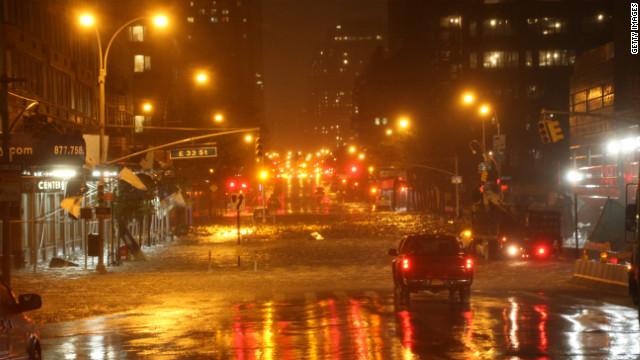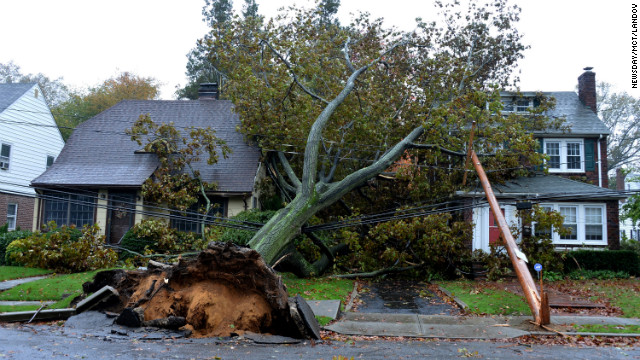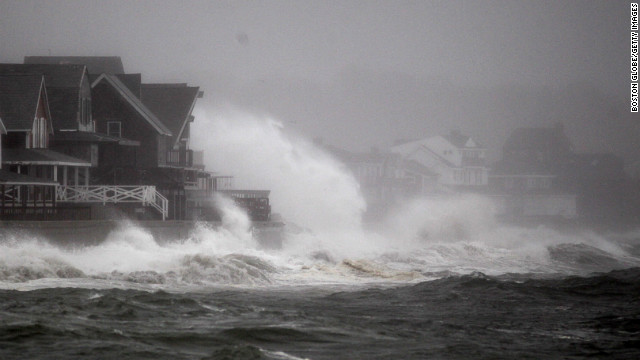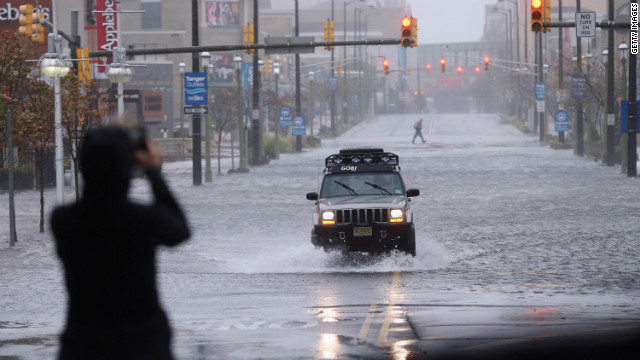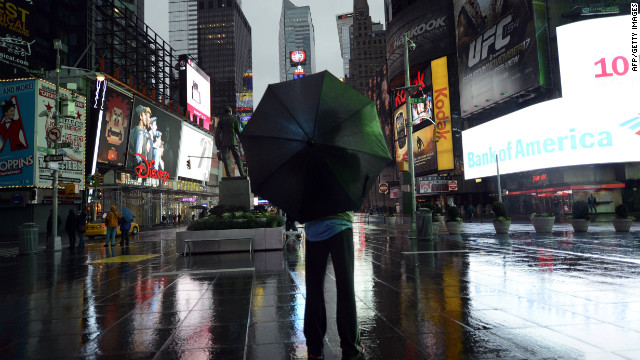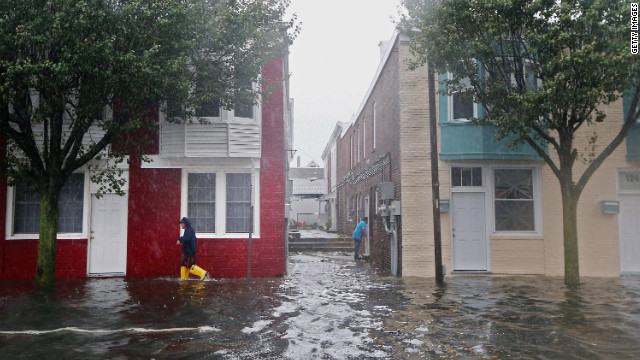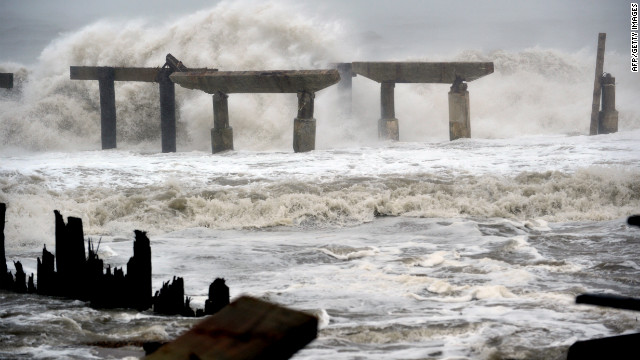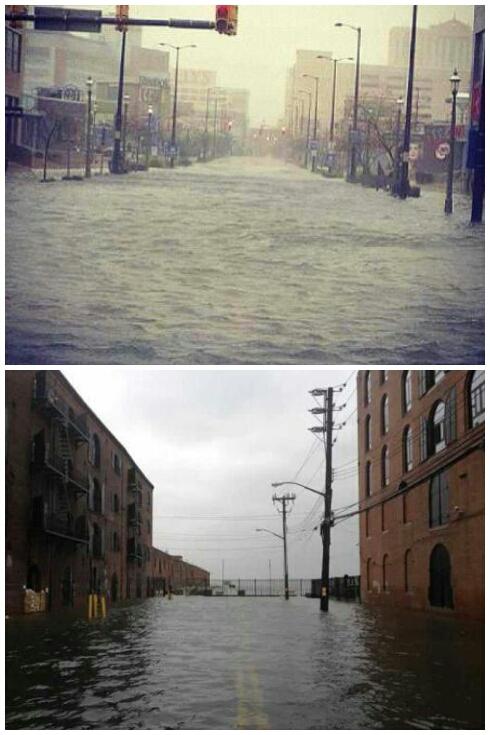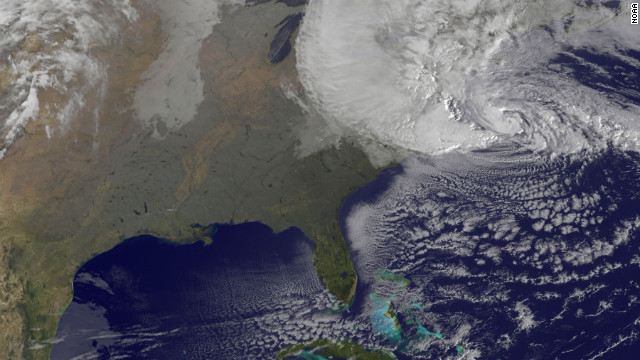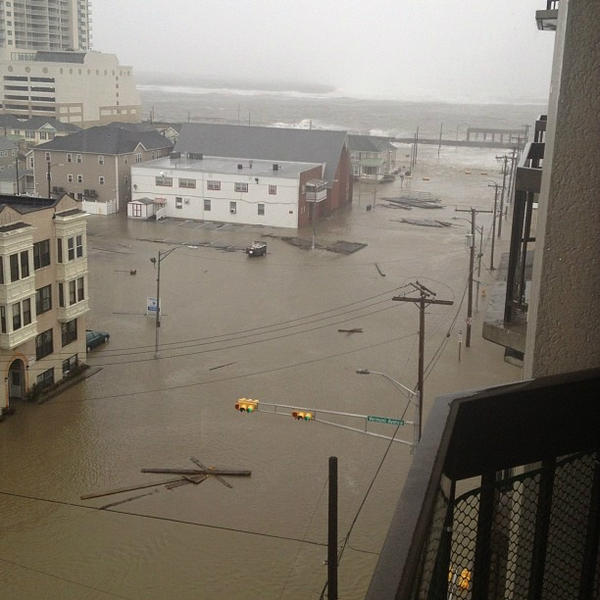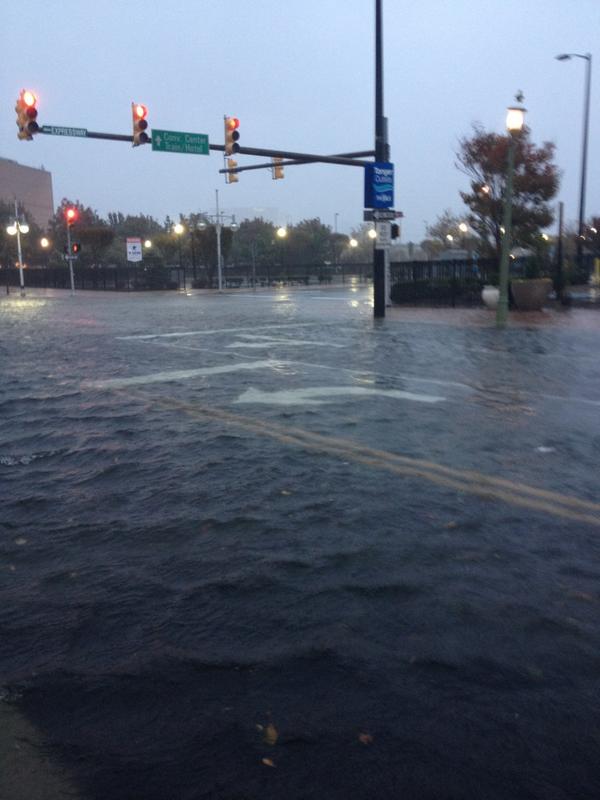M WAQAR..... "A man's ethical behavior should be based effectually on sympathy, education, and social ties; no religious basis is necessary.Man would indeed be in a poor way if he had to be restrained by fear of punishment and hope of reward after death." --Albert Einstein !!! NEWS,ARTICLES,EDITORIALS,MUSIC... Ze chi pe mayeen yum da agha pukhtunistan de.....(Liberal,Progressive,Secular World.)''Secularism is not against religion; it is the message of humanity.'' تل ده وی پثتونستآن
Monday, October 29, 2012
Atlantic City:Empty of Gamblers and Full of Water,
The weather chased them in all its steadfast fury, as if mocking them at every haven they tried. The four of them — a mother, two children and a cousin — thought they could wait the monster out, ride the luck that Atlantic City promises.
But when water rose near their home on Monday, they retreated to a relative’s place. It flooded. They sped to a school converted into a shelter, but they could not stay with their dog, a puppy named Brooklyn. So they were shuttled to the Sheraton Atlantic City Hotel, not far from the famed Boardwalk, where last-minute evacuees were being put up.
Outside, the wind screamed and ankle-deep water lapped at the sides of the hotel. The power was out and the hotel was running a backup generator. The four of them were beyond drenched.
“We’ve never experienced anything like this,” said Cristal Millan, 21, the cousin. “Hopefully the house is still there. To be in the middle of this is scary.”
Hurricane Sandy captured Atlantic City and refused to let go. As the rainwater and surging waters of the ocean that hugged its beaches invaded its streets and wrenched apart pieces of the Boardwalk, the city was left an anxious and isolated island. Inside the casinos, no dice rolled, no cards were dealt and no slots beeped.
“The city is under siege,” said Thomas Foley, the city’s chief of emergency management. “Sandy is pretty furious at Atlantic City. She must have lost a bet or something. As we say in our slogan, ‘Do A.C.’ She’s doing A.C., all right.”
Even as the first samplings of the storm’s ravages descended on the New Jersey coastline, Atlantic City was already in big trouble. At high tide around 8 a.m., officials said 70 to 80 percent of the city was underwater. Water as much as eight feet deep coursed through some streets, leaving them impassable. Heavy rains and sustained winds of more than 40 miles an hour, with gusts of more than 60 miles an hour, battered the city.
The storm made landfall near Atlantic City around 8 p.m. with even stronger sustained winds, reaching up to 80 m.p.h. Late Monday, the bright lights of the city’s casinos remained illuminated, but water surged through its streets once again, reaching thigh-high near the Atlantic City Convention Center.
All arteries leading in were closed, and officials speculated that they might remain shuttered for days. No one could enter Atlantic City. Or leave.
The fate of the city’s residents stoked new tensions between Gov. Chris Christie and Mayor Lorenzo T. Langford, who have long been at odds.
At a news conference early in the evening, Mr. Christie criticized Mr. Langford for telling people they could seek shelter in the city and did not necessarily have to evacuate. “He was sending out a message that was counter to my message,” Mr. Christie said. The phone at the mayor’s office was not answered. The storm’s punch was something unfamiliar to even those like Mr. Foley, who had been in Atlantic City when the savage “Ash Wednesday Storm” of 1962 struck and flooded the city’s grand hotels and tore away part of the Steel Pier, destroying the tank of the diving horse.
“I’ve seen nothing like this one,” Mr. Foley said. “This one has been unbelievable.”
The storm radically transformed this gambling mecca of 40,000 into a chastened city. On the order of Governor Christie, the dozen casinos closed at 4 p.m. Sunday. It was one of only a few times in the gambling industry’s 34 years in New Jersey that wagering was silenced.
About 40,000 casino workers were sent home; each casino retained a skeleton crew of 50 to 75 people for security and surveillance.
“I’ve been working here 32 years and never saw the water this high,” said Toni Rodio, president of the Tropicana Casino and Resort.
By early evening, no flooding was reported in the casinos themselves, though some experienced wind damage.
A citywide curfew took effect at 3:30 p.m., and officials said they did not know when they would lift it.
The National Guard dispatched high-water trucks for the police and firefighters to try to evacuate about 400 people who had become stranded.
Thousands of people had fled on their own; emergency personnel previously shunted about 2,000 residents to shelters inside and outside the city. Rescuers were also using lifeboats to try to reach residents remaining in flooded areas.
“Unfortunately, a lot of people thought this was a hoax or it was not going to hit them,” Mr. Foley, the emergency-management official, said. “Then when water starts coming in their front door, they call.”
The city was taking final evacuees to four last-ditch shelters in Atlantic City. The city earlier had two other shelter options, but they became flooded and had to be abandoned. Late in the day, winds reached speeds at which city officials deemed it too risky to send out rescuers.
Amid everything else, in early afternoon a gasoline spill in City Hall from floating basement gas tanks shorted out some 911 equipment, and the city almost had to abandon its 911 system. It managed to keep it operative.
One 50-foot portion of the Boardwalk, worn down by earlier storms, was chewed apart. Chunks of wood floated down flooded streets like crude rafts. “Timbers on Atlantic Avenue” came reports from first responders on police scanners.
Still, even in the buffeting wind and pelting rain, a few souls with motives of their own dared to venture out. Leamon Davenport, 54, a hospital pediatrician, waded through ankle-deep water on a street by Caesar’s casino. He had come from the boardwalk. He wanted to snap pictures of a fury that was making history.
Hurricane Sandy Threatens $20 Billion in Economic Damage
http://www.bloomberg.comHurricane Sandy may cause as much as $20 billion in economic damage and losses as the biggest Atlantic storm made landfall, flooding homes and offices, after disrupting millions of fliers and forcing stores to close.Insured losses may reach $5 billion to $10 billion, or about half of the total, according to estimates today by Eqecat Inc., an Oakland, California-based provider of catastrophic risk models. Sandy, spanning 900 miles, slammed into southern New Jersey at about 8 p.m. New York time and brought a surge in Manhattan exceeding 13 feet (4 meters). U.S. airlines have grounded about 12,500 flights, stranding travelers, and U.S. stock trading is closed through tomorrow in the first back-to-back shutdowns for weather since 1888. “This one has got so many facets to it -- you’ve got wind, you’ve got rain, you’ve got snow, you’ve got the full moon, you’ve got the storm surge,” said Doug Spiron, who is running home-improvement retailer Home Depot Inc. (HD)’s emergency response operations involving 350 employees in Atlanta. “Then there’s the impact of the sheer size of the storm. This one takes it to another whole level of preparation.” High Tide Record tides from the storm combined with hours of pounding wind and rain to flood electrical substations and shut down New York City’s financial district. Consolidated Edison Inc., the city’s utility, killed power to parts of downtown Manhattan, including Wall Street, and Brooklyn, as the storm surge, boosted by high tide, sent saltwater pouring into its underground power network. Before Sandy made landfall, the storm had knocked out power to more than 2.1 million homes and businesses from North Carolina to New Hampshire, according to utility reports. Power blackouts may eventually affect as many as 10 million people in the region for as long as 10 days. Earlier, before the storm made landfall, rising winds caused the partial collapse of a crane at a West 57th Street luxury tower called One57, designed to be the tallest residential structure in Manhattan at 90 stories. Sandy’s “size is enormous, with storm-force winds extending up to 1,000 miles from the center of the storm on both sides,” Annes Haseemkunju, an atmospheric scientist at Eqecat, said today by telephone. Storm Damage As the storm progresses, economists and analysts have varying estimates on how much damage it will cause. Hurricane Sandy ultimately may subtract 0.1 to 0.2 percentage points from U.S. gross domestic product in the fourth quarter as spending drops on services such as restaurant meals, according to Mark Vitner, a senior economist at Wells Fargo Securities LLC in Charlotte, North Carolina. The economy, with annualized GDP of $13.6 trillion, expanded at a 2 percent pace in the third quarter. “There’s a loss of activity that’s going to be hard to make up,” Vitner said. “If you’re a restaurant and you’re closed today, people are not going to eat two lunches tomorrow.” Insured losses from the storm may reach $8.3 billion, with the largest portion in New York, New Jersey and Pennsylvania, according to an estimate from Kinetic Analysis Corp. compiled by Bloomberg. Suspended Operations In New Jersey, the coastal resort area of Ocean City faces damage from storm surge. The area has 6,246 homes valued at $2.51 billion, according to CoreLogic Inc., an analytics firm which ranked possible storm exposure by Zip code. In the vicinity of Atlantic City and Hammonton, the island community of Margate City has 4,465 residential homes valued at more than $1.4 billion, Irvine, California-based CoreLogic said today in a statement. Boeing Co. (BA), the world’s largest aerospace and defense company, suspended operations today at sites in Virginia, Maryland, New Jersey and Pennsylvania and will determine plans for the remainder of the week on a day-to-day basis. The shutdown includes Chicago-based Boeing’s plant near Philadelphia, where about 6,000 employees build H-47 Chinook helicopters and V-22 Ospreys. Phillips 66 shut down its refinery in Linden, New Jersey, and Hess Corp. (HES) closed a facility in Port Reading, New Jersey, the Energy Department said. The Hess facility doesn’t process crude oil. Other refineries in New Jersey, Pennsylvania and Delaware reduced output, according to the department. ‘Rebuilding Effect’ Exxon Mobil Corp. (XOM), NuStar Energy LP, Phillips 66 (PSX) and Hess closed energy terminals they operate in New York, Connecticut, Massachusetts, Rhode Island, New Jersey, Virginia and Maryland, according to the Energy Department. There’s still a chance the storm will have little discernible impact on GDP, other forecasters said. “Generally there’s a disruption effect and a rebuilding effect,” said Mike Englund, chief economist at Action Economics in Boulder, Colorado. “The disruption effect should last about a week, and the rebuilding effect the following three or four weeks. On net, the rebuilding effect exceeds the disruption effect, but only by a small amount. So we might find by the end of the fourth quarter repair would be a small positive.” Sandy may cut into sales of clothing and accessories as the holiday shopping season nears, according to Oliver Chen, an analyst at Citigroup Inc. in New York. The storm may reduce November same-store sales by as much as 3 percent as traffic may fall 40 percent in storm-affected areas in November’s first week, which accounts for about 22 percent of the month’s sales, Chen said today in a note. Online Spending Consumers who can’t shop in stores because of storm closings may shift to online spending, according to Gil Luria, an analyst at Wedbush Securities in Los Angeles. A shift of one percentage point of revenue to online retailers due to the hurricane would boost fourth-quarter online sales by roughly that much, Luria said today by e-mail. The storm may help discount and home-improvement stores such as Home Depot as consumers stock up on supplies, while reducing purchases at specialty-apparel chains, Chen said. American Eagle Outfitters Inc. (AEO), Limited Brands Inc. (LTD) and Urban Outfitters Inc. (URBN) are among the companies with the highest percentages of their stores affected by the storm, he said. “The storm will disrupt last-minute Halloween sales and mall traffic but drive up stock-up trips to the discounters,” Deborah Weinswig, a Citigroup analyst, said in an e-mail today. As such, she expects Sandy’s impact to be “mixed.”
Hurricane Sandy Slams Ashore and Disrupts Millions of Lives
By JAMES BARRON
Hurricane Sandy battered the mid-Atlantic region on Monday, its powerful gusts and storm surges causing once-in-a-generation flooding in coastal communities, knocking down trees and power lines and leaving hundreds of thousands of people — including a large swath of Manhattan — in the rain-soaked dark.
The mammoth and merciless storm made landfall near Atlantic City around 8 p.m., with maximum sustained winds of about 80 miles per hour, the National Hurricane Center said. That was shortly after the center had reclassified the storm as a post-tropical cyclone, a scientific renaming that had no bearing on the powerful winds, driving rains and life-threatening storm surge expected to accompany its push onto land.
The storm had unexpectedly picked up speed as it roared over the Atlantic Ocean on a slate-gray day and went on to paralyze life for millions of people in more than a half-dozen states, with extensive evacuations that turned shorefront neighborhoods into ghost towns. Even the superintendent of the Statue of Liberty left to ride out the storm at his mother’s house in New Jersey; he said the statue itself was “high and dry,” but his house in the shadow of the torch was not.
The wind-driven rain lashed sea walls and protective barriers in places like Atlantic City, where the Boardwalk was damaged as water forced its way inland. Foam was spitting, and the sand gave in to the waves along the beach at Sandy Hook, N.J., at the entrance to New York Harbor. Water was thigh-high on the streets in Sea Bright, N.J., a three-mile sand-sliver of a town where the ocean joined the Shrewsbury River.
“It’s the worst I’ve seen,” said David Arnold, watching the storm from his longtime home in Long Branch, N.J. “The ocean is in the road, there are trees down everywhere. I’ve never seen it this bad.”
The police said a tree fell on a house in Queens shortly after 7 p.m., killing a 30-year-old man. In Manhattan a few hours earlier, a construction crane atop one of the tallest buildings in the city came loose and dangled 80 stories over West 57th Street, across the street from Carnegie Hall.
Soon power was going out and water was rushing in. Waves topped the sea wall in the financial district in Manhattan, sending cars floating downstream. West Street, along the western edge of Lower Manhattan, looked like a river. The Brooklyn-Battery Tunnel, known officially as the Hugh L. Carey Tunnel in memory of a former governor, flooded hours after Gov. Andrew M. Cuomo of New York ordered it closed to traffic, and officials say water also seeped into subway tunnels.
“We could be fishing out our windows tomorrow,” said Garnett Wilcher, a barber who lives in the Hammells Houses, a block from the ocean in the Rockaways in Queens. Still, he said he felt safe at home. Pointing to neighboring apartment houses in the city-run housing project, he said, “We got these buildings for jetties.”
Hurricane-force winds extended up to 175 miles from the center of the storm; tropical-storm-force winds spread out 485 miles from the center. Forecasters said tropical-storm-force winds could stretch all the way north to Canada and all the way west to the Great Lakes. Snow was expected in some states.
Businesses and schools were closed; roads, bridges and tunnels were closed; and more than 13,000 airline flights were canceled. Even the Erie Canal was shut down.
Subways were shut down from Boston to Washington, as were Amtrak and the commuter rail lines. About 1,000 flights were canceled at each of the three major airports in the New York City area. Philadelphia International Airport had 1,200 canceled flights, according to FlightAware, a data provider in Houston. And late Monday night, Mayor Michael R. Bloomberg said cabs had been instructed to get off New York City roads.
A replica of the H.M.S. Bounty, a tall ship built for the 1962 movie “Mutiny on the Bounty” starring Marlon Brando and used in the recent “Pirates of the Caribbean” series, sank off the North Carolina coast. The Coast Guard said the 180-foot three-masted ship went down near the Outer Banks after being battered by 18-foot-high seas and thrashed by 40-m.p.h. winds. The body of one crew member, Claudene Christian, 42, was recovered. Another crew member remained missing.
Delaware banned cars and trucks from state roadways for other than “essential personnel.”
“The most important thing right now is for people to use common sense,” Gov. Jack Markell said. “We didn’t want people out on the road going to work and not being able to get home again.”
By early evening, the storm knocked out power to hundreds of thousands of homes, stores and office buildings. Consolidated Edison said 68,700 customers had lost power — 21,800 in Westchester County, 18,500 on Staten Island and 18,200 in Queens. In New Jersey, the Public Service Electric and Gas Company said the storm had knocked out power to 36,000 customers. In Connecticut, nearly 70,000 people had lost electricity, utility officials reported. Con Edison, fearing damage to its electrical equipment, shut down power pre-emptively in sections of Lower Manhattan, and then, at 8:30 p.m., an unplanned failure, probably caused by flooding in substations, knocked out power to most of Manhattan below Midtown, about 250,000 customers. About 10 p.m., Mayor Michael R. Bloomberg said that NYU Langone Medical Center’s backup power system was not working and that patients were being moved out.
President Obama,
who returned to the White House and met with top advisers, said the storm would disrupt the rhythms of daily life in the states it hit. “Transportation is going to be tied up for a long time,” he said, adding that besides flooding, there would probably be widespread power failures. He said utility companies had lined up crews to begin making repairs. But he cautioned that it could be slow going.
“The fact is, a lot of these emergency crews are not going to get into position to start restoring power until some of these winds die down,” the president said. He added, “That may take several days.”
Forecasters attributed the power of the storm to a convergence of weather systems. As the hurricane swirled north in the Atlantic and then pivoted toward land, a wintry storm was heading toward it from the west, and cold air was blowing south from the Arctic. The hurricane left more than 60 people dead in the Caribbean before it began crawling toward the Northeast.
“The days ahead are going to be very difficult, Gov. Martin O’Malley of Maryland said. “There will be people who die and are killed in this storm,” he said.
Alex Sosnowski, a senior meteorologist with AccuWeather, said potentially damaging winds would continue on Tuesday from Illinois to the Carolinas — and as far north as Maine — as the storm barreled toward the eastern Great Lakes.
Mr. Cuomo, who ordered many of the most heavily used bridges and tunnels in New York City closed, warned that the surge from Hurricane Sandy could go two feet higher than that associated with Tropical Storm Irene last year. The PATH system, buses and the Staten Island Ferry system were also suspended.
Joseph J. Lhota, the chairman and chief executive of the Metropolitan Transportation Authority, has said he expected to restore at least some service about 12 hours after the storm ended. But possible flooding within the subway system could prevent a full-scale reopening.
The storm headed toward land with weather that was episodic: a strong gust of wind one minute, then mist. More wind. Thin sheets of rain dancing down the street. Then, for a moment, nothing. The sky lightened. Then another blast of rain. Then more wind.
The day brought a giddiness to schoolchildren who had the day off and to grown-ups who were fascinated by the rough, rising water. Some went surfing, discounting the danger. Felquin Piedra, 38, rode his Jet Ski from Queens to Lower Manhattan.
“I love the waves,” Mr. Piedra yelled from New York Harbor. “The water is warm. I’ve jumped in several times.”
But even when landfall was still hours away, there was no holding back the advance guard of the storm — fast-moving bands of rain and punishing winds.
It added up to devastation. Driving through places like Pompton Plains, N.J., late Monday afternoon was like an X-Games contest for drivers. They had to do tree-limb slaloms on side streets and gunned their engines anxiously as they passed wind funnels of leaves swirling on highways.
On City Island, off the Bronx mainland, Cheryl Brinker sprayed “Sandy Stay Away” on her boarded-up art studio, expanding a collage she started during Tropical Storm Irene last year. But by midafternoon, nearby Ditmars Street was under as much as five feet of water and Steve Van Wickler said the water had cracked the cement in his cellar. “It’s like a little river running in my basement,” he said. “There are cracks and leaks everywhere.”
In some places, caravans of power-company trucks traveled largely empty roads; Public Service Electric and Gas said that 600 line workers and 526 tree workers had arrived from across the country, but could not start the repairs and cleanup until the wind had subsided, perhaps not until Wednesday.
They will see a landscape that, in many places, was remade by the storm. In Montauk, at the end of Long Island, a 50-seat restaurant broke in half. Half of the building floated away and broke into pieces on the beach.
The 110-foot-tall lighthouse at Montauk Point — the oldest in the state, opened in 1796 — shuddered in the storm despite walls that are six feet thick at the base. The lighthouse keeper, Marge Winski, said she had never felt anything like that in 26 years on the job.
“I went up in tower and it was vibrating, it was shaking,” she said. “I got out of it real quick. I’ve been here through hurricanes, and nor’easters, but nothing this bad.”
Superstorm Sandy loses hurricane status
http://townhall.comForecasters say Sandy is no longer a hurricane but is still a dangerous system taking dead aim at New Jersey and Delaware. The National Hurricane Center said Monday evening that Sandy is a post-tropical storm and losing strength but still has sustained winds at 85 mph. The eye has almost made landfall. The center says storm surge has reached heights of 12.4 feet at Kings Point, N.Y. Gaining speed and power through the day, the storm knocked out electricity to more than 1.5 million people and figured to upend life for tens of millions more. It clobbered the boarded-up big cities of the Northeast corridor, from Washington and Baltimore to Philadelphia, New York and Boston, with stinging rain and gusts of more than 85 mph.
Hurricane Sandy Near Landfall, Storm Pounds East Coast
NEW YORK TIMESHurricane Sandy churned relentlessly through the Atlantic Ocean on Monday on the way to carving what forecasters agreed would be a devastating path on land that is expected to paralyze life for millions of people in more than a half-dozen states, with extensive evacuations, once-in-a-generation flooding, widespread power failures and mass transit disruptions. The huge storm, which picked up speed over the water on Monday morning, was producing sustained winds of 90 miles per hour by 11 a.m., up from 75 m.p.h. on Sunday night. The center of Hurricane Sandy made its expected turn toward the New Jersey coast early on Monday. The National Hurricane Center said the center of the storm was now moving north-northwest at 28 m.p.h. At 2 p.m., the center said that the center of the storm was about 110 miles from Atlantic City, where the boardwalk had been damaged, and 175 miles from New York City. In Manhattan, the top section of a crane atop a luxury building under construction on West 57th Street near Central Park had toppled over and was dangling about 80 stories above the ground. Even with landfall still hours away, there was no holding back flooding from the advance guard of the storm — fast-moving bands of rain that lashed protective barriers in beachfront communities and then pushed inland. In Delaware, some oceanfront roads in Rehoboth Beach were underwater and structures destroyed. In Maryland, the normally placid Sligo Creek in the Washington suburb of Takoma Park turned into a torrent. In Ocean City, Md., the boardwalk pier was “significantly damaged” overnight, said Mike Levy, a public information officer for the Police Department there. President Obama returned to the White House on Monday and met with top advisers before speaking to reporters. “This is going to be a big storm,” he said, urging people to follow mandatory evacuation orders. “It’s going to be a difficult storm.” Mr. Obama said the storm would disrupt the rhythms of daily life in the states it hit. “Transportation is going to be tied up for a long time,” he said, adding that besides flooding, there would probably be widespread power failures. “The fact is, a lot of these emergency crews are not going to get into position to start restoring power until some of these winds die down.” He added, “That may take several days.” When a reporter asked about the hurricane’s impact on the campaign, the president said: “I am not worried at this point about the impact on the election. I’m worried about the impact on families, and I’m worried about our first responders.” Broad Area of Strong Winds Hurricane-force winds extend up to 175 miles from the center of the storm; tropical-storm-force winds extend up to 485 miles from the center. This means that portions of the coast from Virginia to Massachusetts will feel hurricane-force winds as the storm moves toward land, according to forecasters. Winds of tropical-storm force could stretch all the way north to Canada and all the way west to the Great Lakes, where flood warnings were issued on Sunday. Some states expected snow, with blizzard warnings issued for mountainous stretches of Maryland, Virginia and West Virginia. Officials warned that the powerful surge the storm was creating in the ocean, combined with the strong winds, could wreak destruction in the Northeast for days. The hurricane center warned that “normally dry areas near the coast” would be flooded. Millions of people were expected to lose electricity as the hurricane felled trees and light poles and ripped down power lines. As the storm closed in on some of the nation’s most densely populated areas, city and state officials went into emergency mode. The New York City subway system and all of the region’s commuter trains and buses were shut down, and crews moved subway cars and locomotives to high ground. The major stock exchanges called off all trading for Monday and Tuesday, and Broadway theaters canceled their shows on Sunday evening and Monday. Warning that the flooding would be “life-threatening,” forecasters and government officials implored residents in the areas designated for evacuation not to try to ride this storm out. “We’re going to have a lot of impact, starting with the storm surge,” said Craig Fugate, the administrator of the Federal Emergency Management Agency. “Think, ‘Big.’ ” Evacuations in New York In New York, Mayor Michael R. Bloomberg ordered the evacuation of more than 370,000 people in low-lying communities from Coney Island in Brooklyn to Battery Park City in Manhattan and gave 1.1 million schoolchildren a day off on Monday; he also announced that schools would remain closed on Tuesday. The city opened evacuation shelters at 76 public schools. Gov. Andrew M. Cuomo, who warned that the surge from Hurricane Sandy could go two feet higher than Tropical Storm Irene last year, announced that the Holland and Brooklyn-Battery Tunnels would close at 2 p.m. State officials said the two tunnels were prone to flooding. As for other bridges and tunnels, the governor said that they would be blocked off if winds exceeded 60 m.p.h. Some forecasts, he noted, are already calling for blasts of 90 m.p.h. Joseph J. Lhota, the chairman and chief executive of the transportation authority, said the Queens-Midtown Tunnel had never been closed because of high winds. But he said that if water poured in at one end or the other — in Manhattan or in Queens — “we will recommend to governor that that happen.” Mr. Lhota said he expected the transit systems to restore at least some service about 12 hours after the storm ended. But he warned that the city could be without mass transit for as many as two full workdays. The PATH system, buses and the Staten Island Ferry system were also suspended. Power Concerns Another fear in the Northeast was that winds from the storm might knock down power lines, and that surging waters could flood utility companies’ generators and other equipment. Consolidated Edison did not provide an estimate of how long customers in the New York City area might be without power if the storm played havoc with its network. But Jersey Central Power and Light warned as long ago as Friday that repairs could take 10 days after the storm passed through. Another utility in New Jersey, the Public Service Electric and Gas Company, said restoring power could take a week. PECO, the southeastern Pennsylvania utility, reported only scattered power disruptions by about 9 a.m. on Monday but warned that customers would probably go days without electricity when the full effects of the storm were felt. “With a storm of this magnitude, we are looking at a multiday restoration,” said Martha Phan, a spokeswoman for the utility. Gov. Jack A. Markell of Delaware decided Sunday night to close all state roads at 5 a.m. Monday, with exceptions for emergency workers and other essential personnel. “People have had several days to be out preparing for the storm’s arrival,” Mr. Markell said in a statement. “When Sandy hits on Monday, they should be at home or if necessary a shelter to wait out the worst of the storm. Do not put yourself on the road. Do not put yourself and those who may need to rescue you at risk.” Creeping Storm Surge Forecasters said the hurricane was a strikingly powerful storm that could reach far inland. Forecasters said they expected high-altitude winds to whip every state east of the Mississippi River. In Atlantic County, N.J., which includes Atlantic City, a curfew and a driving ban were put in place at midnight. Gov. Chris Christie had ordered residents to leave barrier islands from Sandy Hook to Cape May, and early on Monday, local authorities said about 400 people were staying in shelters. For the most part, residents appeared to follow officials’ advice to stock up on bottled water, canned food and flashlights — so much so that stores ran low on batteries. Some gas stations in Connecticut had little gasoline left — no regular, and not much premium. In an early briefing on Monday, Gov. Dannel P. Malloy, in Connecticut, said 850 national guardsmen and women had been deployed. A storm surge of between 7 feet to 11 feet was expected, with New London and Bridgeport especially hard hit, and the worst winds would sweep through from 3 p.m. to about 3 a.m. Tuesday, with gusts of wind as high as 90 m.p.h. Power failures could last “a long period of time,” Mr. Malloy said. “Stay home,” he added. “Let me repeat that: Stay home.” The governor said the potential for loss of life was “extremely high.” “This is the most catastrophic event that we have faced and been able to plan for in any of our lifetimes,” he said. Air Travel Troubles Even before the storm landed, transportation systems were shut down. The nation’s major airlines canceled thousands of flights in the Northeast. Bradley International Airport near Hartford was closing on Monday afternoon, Mr. Malloy said. But the three major airports in and around New York City remained open on Monday morning, even though the airlines had canceled all flights into and out of them, said Steve Coleman, a spokesman for the Port Authority of New York and New Jersey. Mr. Coleman said there were about 30 stranded passengers at La Guardia Airport in Queens and about 30 more at Newark Liberty International Airport in New Jersey. He did not provide an estimate for Kennedy International Airport, also in Queens. He said that the Port Authority had provided cots and blankets to the travelers and that they were welcome to stay until the storm passes. Service on the AirTrain shuttles to Kennedy and Newark has been suspended, he said. Many public libraries said their reading rooms would be closed for the day, and parks department workers in Central Park told people to leave on Sunday and to stay away until the storm passed. The New York Stock Exchange, which initially said its trading floor would be open on Monday, decided to close the floor and suspend all trading on Monday. The Nasdaq exchange also announced it would be closed on Monday. Forecasters said Hurricane Sandy could deliver something besides wind and rain: snow. Several feet of heavy, wet snow was expected in West Virginia and lighter amounts in Pennsylvania and Ohio that could bring down trees and power lines if already chilly temperatures drop below freezing. The full moon on Monday could cause even greater flooding, because tides will be at their peak. But it was the possibility of a surge that prompted many to take precautions. The hurricane center said the surges could reach 11 feet in New York Harbor, Long Island Sound and Raritan Bay in New Jersey — significantly higher than previous forecasts and significantly above the levels recorded during the tropical storm last year. Forecasters said the water could top eight feet from Ocean City, Md., to the border between Connecticut and Rhode Island. They predicted the waves would rise to six feet on the south shore of Cape Cod. A higher surge was one reason that Mayor Bloomberg ordered mandatory evacuations in low-lying areas of New York City, just as he did before Tropical Storm Irene. One city official said there was particular concern about Con Edison’s Lower Manhattan infrastructure, noting that if the storm surge washed over the bulkheads, it could damage the utility’s electrical and steam networks. If the surge runs as high as forecast, Con Ed will shut off two electrical networks in Lower Manhattan. As Governor Cuomo announced that two New York City tunnels would be closing by midafternoon, many people took advantage of the arteries that connect Manhattan with other boroughs until the last minute, to get to work, or wondered how they would return home. Michael Maxwell, 56, a porter at the Sweeney Building, a luxury condominium at 30 Main Street in Dumbo neighborhood of Brooklyn, had taken a car service from Canarsie to arrive at his morning shift. If he finished early, he said, he hoped to be able to take a car service home; otherwise, he would sleep in the locker room.
Hurricane Sandy speeds up, could hit Atlantic City area by 4 p.m., forecasters warn
The massive swirl that is Hurricane Sandy has now officially turned toward New Jersey, accelerating quickly and expected to make landfall near Atlantic City as early as 4 p.m. today, forecasters say.
In its 2 p.m. briefing, the National Hurricane Center said Sandy is now moving northwest at 28 mph, with maximum sustained winds of 90 mph, and set to make landfall as the most powerful hurricane to ever make landfall in New Jersey.
The hurricane has accelerated dramatically since the last briefing just three hours ago, with New Jersey bracing for the most intense weather starting to occur in the southern and central coastal areas. Now just 110 miles away from land, Sandy is already hammering New Jersey with lashing winds and flooding rains, bringing rail and road travel to a near standstill. Government offices are shuttered and towns along the coast have been evacuated.Conditions are quickly deteriorating in Seaside Heights, where the wind and rain have kicked up considerably in the past hour. The storm surge near Funtown Pier seemed much stronger around 1:30 p.m., with waves cresting high and a series of violent white caps pounding the sand dunes, threatening to wash them away.
At the 14th Avenue pier, the Atlantic Ocean was also raging as driving rains and swirling winds were splashing over a boat ramp and violently clawing at a portable dock..
More than 50,000 customers are already without power throughout the state, especially along the coast.
Jersey Central Power & Light is reporting 20,000 outages in Monmouth and Ocean counties. In Atlantic City, another 3,000 outages were reported, along with another 2,000 customers around the tip of Cape May. Public Service Electric & Gas, the state's largest utility, said thousands more are without power in Essex, Union and Burlington counties.
In a public briefing from the State Police regional operations center, Gov. Chris Christie said residents have heeded mandatory evacuation orders in most barrier island communities. But in places like Seaside Heights and Brigantine, many stayed put, a decision the governor called “stupid and selfish.”We already have rescues ongoing on the barrier islands,” he said earlier today. “This is putting first responders in significant, significant danger and it’s not fair to their families to be putting them in danger because you decided to be hardheaded.”
In Cape May, officials warned residents that the window of opportunity to safely evacuate had all but closed, and that they cannot guarantee help for those who chose to stay. In a press conference earlier, Mayor Edward Mahaney said fewer than 500 people ignored the mandatory order, at their peril.
“Anyone who stayed past 4 o’clock yesterday, we are not able to guarantee that we’ll be able to affect a rescue or any service to them of public safety nature in the height of the storm,” he said.
Cathy Dollinger is one of those residents. She boarded up her Lafayette Street home with the same plywood she used last year for Tropical Storm Irene. But that time around, she took her mother and her dog up to her brother's house in Brooklyn. Now, she plans on staying put.
"I'm not sure we made such a good decision this time," she said as storm coverage on television played in the background.
But, she said, she stocked up on provisions and thinks they'll be ok. "This house has been here for eons," she said. "It's over 100 years old."Roadways are closing quickly, with Garden State Parkway now shuttered in both directions south of Exit 63 in Stafford Township, Ocean County, the exit motorists take to Long Beach Island. The roadway will shut down south of Exit 129, where the Turnpike crosses the Parkway, beginning at 4 p.m. Earlier, a 35-mile stretch of the Parkway below Exit 38 was closed around 10 a.m.
"Motorists should anticipate significant closures on the Turnpike and Parkway as conditions continue to deteriorate throughout the day and into the evening," Christie said this afternoon during his latest hurricane briefing, in Ewing. "As I’ve said again, stay off the road. You’re not just putting yourself in danger, but you’re putting others’ lives in danger."
A travel ban remained in effect in Atlantic County.
Across the Hudson River, America’s largest city is becoming a ghost town. The Holland and Brooklyn Battery tunnels were shut down at 2 p.m., a day after subway service shut down for only the second time in its history.
Christie said every school in New Jersey was closed for today and more than half the districts had already decided to call off classes for Tuesday.
In northern New Jersey, residents living in river communities are bracing for another round of the flooding that has become commonplace for them.
By midday, the Hudson River was already out of its banks in Hoboken. Residents of Pompton Lakes, where the flood-prone Wanaque and Pequannock Rivers meet, put belongings out near the curb in advance of the storm.
President Obama signed an emergency declaration for New Jersey on Sunday, allowing the state to request federal funding and other assistance for action taken in advance of the storm.
Hurricane Sandy Turns To The Northwest
http://www.wunderground.com
Wind: 90 MPH — Location: 38.3N -73.1W — Movement: NWLOCATION: 38.3N 73.1W (108 miles southeast of Atlantic City, NJ and 175 miles South/Southeast of NYC) • WIND: Max sustained winds at 90 miles per hour (150 km/h) • MOVING: Northwest at 28 MPH (44km/h) Very dangerous Hurricane Sandy is currently making her long-awaited turn to the northwest toward the Mid-Atlantic coast. Landfall is expected later Monday night along the southern coast of New Jersey. Coastal flooding has already begun and historical storm surges are likely.
President Obama on Hurricane Sandy Preparations
http://blogs.wsj.com
REMARKS BY THE PRESIDENT ON HURRICANE SANDY FEMA Headquarters. Washington, D.C.THE PRESIDENT: Well, good afternoon, everybody. Obviously, all of us across the country are concerned about the potential impact of Hurricane Sandy. This is a serious and big storm. And my first message is to all the people across the Eastern seaboard, Mid-Atlantic, going north, that you need to take this very seriously and follow the instructions of your state and local officials, because they are going to be providing you with the best advice in terms of how to deal with this storm over the coming days. We just had an excellent meeting with the FEMA team here, the various agencies that are in charge, including the Department of Defense, the Department of Energy and others that are going to need to respond very quickly. Under Craig Fugate’s leadership here at FEMA we’ve had a chance to talk to the regional officials as well. And I just had a phone call with the governors of the potentially impacted states, as well as some of the major cities in the region. At this stage, everybody is confident that the staging process, the prepositioning of resources, commodities, equipment that are going to be needed to respond to this storm are in place. But as Craig has emphasized, this hasn’t hit landfall yet, so we don’t yet know where it’s going to hit, where we’re going to see the biggest impacts. And that’s exactly why it’s so important for us to respond big and respond fast as local information starts coming in. I want to thank all the members of the team for the outstanding work that they’re doing. But the other thing that makes this storm unique is we anticipate that it is going to be slow moving. That means that it may take a long time not only to clear, but also to get, for example, the power companies back in to clear trees and to put things back in place so that folks can start moving back home. So my main message to everybody involved is that we have to take this seriously. The federal government is working effectively with the state and local governments. It’s going to be very important that populations in all the impacted states take this seriously, listen to your state and local elected officials. My message to the governors, as well as to the mayors, is anything they need, we will be there. And we’re going to cut through red tape. We’re not going to get bogged down with a lot of rules. We want to make sure that we are anticipating and leaning forward into making sure that we’ve got the best possible response to what is going to be a big and messy system. So again, thank you, everybody. Craig, would you like add to something? MR. FUGATE: Again, as the President says, it’s going to really come down to the public heeding those evacuation orders, taking protective measures. If they haven’t gotten ready, they can go to Ready.gov. Get information on how to protect them and their families, but also check on your neighbors. This is going to be a big storm. We need to be there for each other. THE PRESIDENT: Okay. Let me emphasize that again — Ready.gov — for the general public. If you need to know how to respond, that’s where you can get centralized information. But I think Craig’s point is exactly right. In times like this, one of the things that Americans do is we pull together and we help out one another. And so, there may be elderly populations in your area. Check on your neighbor, check on your friend. Make sure that they are prepared. If we do, then we’re going to get through this storm just fine. But we’re going to have to make sure that we are vigilant, and vigilant for a couple of days. Don’t anticipate that just because the immediate storm has passed that we’re not going to have some potential problems in a lot of these communities going forward through the week. All right. Thank you very much, everybody.
Hurricane Sandy Hits New Jersey,New York
Hurricane Sandy is a Category 1 storm with a maximum wind speed of 86 mph. It is currently moving to the north at 20 mph.
Live Video app for Facebook by Ustream As Hurricane Sandy battered coastal New Jersey on Monday morning, Atlantic City felt some of its worst effects, with floodwaters surging through the streets and emergency responders facing mounting calls to evacuate residents who tried to ride out the storm. Pounding waves have already broken up sections of the Atlantic City boardwalk, according to photos posted to social media and discussion on police and fire scanners. "Be advised that there are heavy timbers floating in Atlantic Avenue," a first responder alerted dispatchers on the Atlantic City police and fire scanner at 10 a.m. Willie Glass, Atlantic City's public safety director, told the Associated Press that "most of the city is under water." The National Weather Service station in Mt. Holly, N.J., warned early Monday morning that the storm was poised to make a direct strike on New Jersey and cause devastation up and down the state. "This is an extremely dangerous situation for our area," forecasters wrote.
Obama declares New Jersey a disaster area
http://www.pressofatlanticcity.comPresident Obama has declared New Jersey a disaster area, hours before Hurricane Sandy is expected to make landfall in South Jersey. Flooding from this morning’s high tide exceeded major levels throughout the region, nearing 8.3 feet in Atlantic City and 8.8 feet in Cape May, tying a record set in 1985 from Hurricane Gloria. Atlantic City authorities have made numerous water rescues in the city as residents, particularly in the Inlet section, Back Maryland and near Gardner’s Basin found their homes flooded with water at least three feet deep in places. Gov. Chris Christie ordered the state to close the Garden State Parkway south of the Atlantic City Expressway (Exit 38) due to flooding along the road and at numerous exits. Roads into barrier islands also are under water and some residents who stayed on barrier islands now are reconsidering their decisions. Brigantine Police told residents in a news release that they may have a brief window this afternoon to escape the island, but that was not certain. About 70 percent of the residents there stayed despite a mandatory evacuation order, police said. Police told residents that they need to prepare to shelter in place for the duration of the storm. Sandy still has winds of 85 mph and a continued strengthening of the system means it will be the most intense storm of the modern era to make landfall in the Northeast United States, according to the National Weather Service. The tide at Atlantic City remained at more than 8 feet, which is the threshold for major flooding, for more than an hour and a continued increase of onshore wind speeds may mean that water might not drop very far in the back bays, the weather service said. Forecasters have likened the effects of Sandy to those of the famous March Storm of 1962, which lasted five successive high tides. Reports of the ocean breaching dunes are increasing, including on Long Beach Island and in Cape May. Atlantic City patrol officers are working 12-hour shifts, driving Public Works trucks to navigate the city's streets. Fairmount and Arctic avenues were impassible, police said. Police and fire personnel will continue to help with rescues, Public Safety Director Willie Glass said. Rather than report to the Cape May County Police Academy today, the city's eight police recruits reported to the police compound to assist in whatever way they are needed, police said. “We’re breaking new ground here. (The water) will go places it never has gone before,” said Gary Szatkowski, a senior meteorologist with the National Weather Service in Mount Holly, Burlington County. “No one has seen it in their lifetime.” Gov. Chris Christie asked President Barack Obama on Sunday for a pre-landfall disaster declaration, which would help speed up relief efforts through the Federal Emergency Management Agency. Christie also mobilized the National Guard to assist local authorities. FEMA Administrator Craig Fugate said on a morning conference call that the agency already is mobilizing supplies and personnel to begin the relief effort as soon as conditions allow, but warned that residents throughout the region, including those inland, will contend with extended power outages and need to be prepared to be on their own for three days. Transportation throughout the state also will be at a standstill as NJ Transit suspended all operations, as did private bus carriers. Other than essential emergency personnel, nearly all state, local and county offices, along with courts and schools, are closed Monday and likely Tuesday. Atlantic City Electric warned that outages could take days to restore and the utility would not be issuing restoration time estimates until the preliminary damage assessment is conducted, which won’t occur until the storm has passed. Forecasters predict up to 12 inches of rain could fall across South Jersey and inland flooding could be extensive, especially along major river systems. On Sunday evening, buoys in the Atlantic Ocean recorded wave heights nearing 40 feet, and forecasters predicted waves near shore could reach 16 feet, with breakers on shore reaching up to 12 feet high. Szatkowski told residents who were thinking of staying to talk to anyone who lived through the March Storm of 1962 and ask whether they’d live through that same storm again. He wrote in a heart-felt plea to residents along the shore to consider loved ones and that if they thought he overhyped the storm, that they could call him Friday to yell at him. “Think about the emergency responders who will be unable to reach you when you make the panicked phone call to be rescued,” he wrote. “Think about the rescue/recovery teams who will rescue you if you are injured or recover your remains if you do not survive.” Ann Kooperman, who was 10 years old during the 1962 storm and lived on the bay side of North Tallahassee Avenue in Atlantic City at the time, said she is staying at her Ventnor Heights home that is directly on the Intracoastal Waterway. Kooperman’s husband, Steve, built the house at an elevation of 14 feet, so she is not concerned about water in the house. “My daughter asked us to come over (to Egg Harbor Township) and even cleaned a room for us. I thought it’s just going to be as bad over there with the trees. I’m more afraid of the trees than I am of flooding,” Kooperman said. “I’m a born and bred bay rat.” However, Kooperman said, if she were living on the beach block, her plans would be different: “If I was on the beach block, I’d be long gone.” While building codes and beach replenishment have added a level of strength to the islands’ infrastructure in places since 1962, the sea level also has risen about six inches and, Szatkowski warned, no building standard could stand up to the erosive power of the water if it begins to cut into the island and creates a new inlet, as occurred on Long Beach Island in 1962. “Even the best constructed home, if that’s where Mother Nature decides to start scouring a new inlet, that’s the danger when you get that much water moving,” he said. “You’re going to see some erosion beyond anything you can imagine.
Flooding rescues under way as Sandy threatens 'catastrophe' of a lifetime
People stranded in flooding after ignoring evacuation orders were being saved Monday morning as Hurricane Sandy took aim at the Mid-Atlantic coast, bringing some of the nation's busiest cities to a standstill.
Dramatic rescue efforts were under way in Oak Orchard, Delaware, a community along the Indian River Bay and a part of the state that was under a mandatory evacuation over the weekend. Officials across the Eastern Seaboard had implored residents to obey evacuation orders, emphasizing that local authorities could be put in danger if they tried to save them.
New Jersey Gov. Chris Christie put it most bluntly: "Don't be stupid. Get out!"
Still, some didn't leave. Delaware Gov. Jack Markell said the National Guard and local fire and police officials were rescuing people in his state early Monday.
It's just one of the scenes that make Sandy seem straight out of a disaster blockbuster: A killer storm takes aim at one of the most populated regions of the country."This is the most catastrophic event that we have faced and been able to plan for in any of our lifetimes," Connecticut Gov. Dan Malloy warned.
An expected storm surge at midnight could raise water levels to 11 feet above normal high tide, bringing "the potential to cause unprecedented damage."
Mass transit grinds to a halt
Along the Eastern Seaboard, hundreds of thousands of people have been forced from their homes. New York City landmarks are eerily empty. The nation's capital is emptied of government workers. Much of the region was settling into paralysis, bracing for what's to come.
From North Carolina to Maine, forecasters warned that Sandy was likely to collide with a cold front and spawn a "superstorm" that could generate flash floods, snowstorms and massive power outages.
About 50 million people, from Virginia to Massachusetts, are expected to feel the effects of Sandy.
"It could be bad," said U.S. Coast Guard Rear Adm. Steven Rattior, "or it could be devastation."
And the impact isn't limited to the East Coast. Wave heights in Lake Michigan could reach 28 feet Monday night and 31 feet by Tuesday, the National Weather Service said.Sandy already proved its deadly wrath, claiming at least 67 lives, 51 in Haiti alone, as it smashed through the Caribbean last week.
Federal, state, and local U.S. officials have been working hard to bang out the message that Sandy is dangerous.
Newark Mayor Cory Booker told CNN early Monday: "My biggest concern is just people not taking it seriously and not taking the proper precautions. We still have some time for people to get ready. ... We anticipate there could be many days without power afterward."At 8 a.m., Sandy, a Category 1 hurricane, was 265 miles southeast of Atlantic City, New Jersey, and about 310 miles south-southeast of New York City, the center said. Maximum sustained winds were at 85 mph, and Sandy was moving north-northwest at about 20 mph.
Hurricane-force winds extended outward 175 miles from the center, and tropical storm-force winds reached 485 miles.
The center is expected to reach the coast Monday evening and make landfall between 8 p.m. and 2 a.m. on the Delmarva Peninsula -- an area occupied by parts of Delaware, Maryland and Virginia -- or Jersey Shore.
By the time it reaches the coast, Sandy may not officially be a hurricane, but its widespread effects will be the same either way, CNN meteorologist Dave Hennen warns.
But even with the storm hundreds of miles offshore, officials were warning of Sandy's life-threatening, storm-surge flooding portions of the Mid-Atlantic, including low-lying areas of New York and New Jersey.Michelle Franchaise of Ocean Gate was among the tens of thousands in New Jersey ordered to leave their coastal communities Sunday.
She and more than 180 others hunkered down at an emergency shelter in Toms River, New Jersey, to ride out the storm. She selected one of the 250 green cots that lined the floor.
"I'm very concerned when I see the map, and I see how big it is," she said. "I think I'm in good hands here. I think I'm safe."
At least 60 people at the Toms River shelter brought their pets.
"The cops came around and were like, 'If you don't leave, you're going to be arrested,' " one woman said while cradling one of four kittens she brought with her. "I couldn't leave without them."By early Monday, the city that never sleeps bedded down after shuttering its bus and train lines, closing schools and ordering about 400,000 people out of their homes in low-lying Manhattan and elsewhere.
The process of halting subway service in New York began Sunday night. Other mass transit systems are doing the same by suspending their services Monday, including Washington's Metro service and Southeastern Pennsylvania Transportation Authority trains and buses in and around Philadelphia.In Sea Bright, New Jersey, Yvette Cafaro scrawled a plea on the plywood that covered up her burger restaurant: "Be kind to us Sandy."
The seaside area largely dodged last year's Hurricane Irene, and Cafaro is hoping for, but not expecting, another reprieve.
"Everything that we've been watching on the news looks like this one will really get us," she said. "We're definitely worried about it. ... Hopefully, she'll spare us."
After filling his trunk with sandbags Sunday in Cranston, Rhode Island, resident Steve Pacheco said he had done what he could by clearing Halloween decorations and other items from his yard. Still, for all his preparation, he admitted that Sandy made him nervous.
"I don't want to go through this again," Pacheco told CNN affiliate WPRI-TV in Providence.
The price tag for potential wind damage alone is estimated between $2.5 billion and $3 billion, according to the Federal Emergency Management Agency.
The estimate doesn't take into account potential flooding and other damage, though the federal government pre-emptively declared states of emergency in a number of locales to help states cope with Sandy and its aftermath.Officials have canceled classes Monday for more than 2 million public school students in districts such as New York, Philadelphia, Boston and Baltimore, while numerous universities as well as federal government offices in Washington and government offices in states like New Jersey were closed.
The U.S. stock exchanges will be closed Monday and possibly Tuesday, announcements that followed soon after New York declared a state of emergency Sunday.
The last time the New York Stock Exchange closed for a weather event was in 1985, during Hurricane Gloria. And in 1969, a snowstorm also brought the exchange to a halt.
Sandy has even managed to put the presidential election on the back burner, turning campaign plans upside down.
Politicos from both sides said it is still too early to tell what effect the storm will have on the presidential race, though the access to voting centers will be a concern if the storm persists until Election Day.
"I don't think anybody really knows," top Obama adviser David Axelrod said on CNN's "State of the Union."
"Obviously, we want unfettered access to the polls because we believe that the more people come out, the better we're going to do, and so to the extent that it makes it harder, you know, that's a source of concern. But I don't know how all the politics will sort out."
Virginia's Republican governor said Sunday that his state would take measures to ensure residents are able to vote despite obstacles the storm might bring.Then there are the travel nightmares that the storm has and will continue to cause -- with thousands of flights called off, Amtrak train runs scuttled and hundreds of roads and highways expected to flood.
"This is not a typical storm. It could very well be historic in nature and in scope and in magnitude because of the widespread anticipated power outages, flooding and potential major wind damage," Pennsylvania Gov. Tom Corbett said, speaking of his state but just as well about many others in the Mid-Atlantic and Northeast.
"Essentially, this is a hurricane wrapped in a nor'easter."Janie Lambert of Hughesville, Maryland, stopped for a look Sunday at the beach at the Pax River Naval Station along the Chesapeake Bay.
The typically calm surf churned violently, pushed by winds so powerful that it nearly knocked her off her feet when she got out of her car to videotape it.
"We made it safely home," she said. "But I know this is only the beginning of several scary days ahead."
Malala Yousufzai status updates 10/29/2012
Malala Yousufzai spent a restful weekend at the Queen Elizabeth Hospital Birmingham surrounded by her family, who arrived in the UK last week.
She continues to make good progress and is grateful for the 5,000 messages of support that have been posted via the Trust’s website.
PPP has full confidence on CEC
President of Pakistan People's Party Central Punjab Mian Manzoor Ahmad Wattoo has said that the PPP government has full confidence on the Chief Election Commissioner that he will conduct next general elections impartially. Talking to the party workers in Chichawatni he said that Nawaz Sharif and Shahbaz Sharif should quit politics on account of their involvement in election rigging in 1990.
FM Khar heads to Cairo on three-day visit
Pakistan’s Foreign Minister Hina Rabbani Khar on Monday departed on a three-day official visit to Cairo where she will meet the top leadership of the newly formed Egyptian government.
During her three days in Cairo, Foreign Minister Khar is scheduled to meet the newly elected President of Egypt Mohammad Morsi as well as other key figures of the Egyptian government. The meetings are aimed at strengthening of ties between the two Muslim countries, while cooperation in other areas will also be discussed.
Mohammad Morsi, a former leader of the powerful Muslim Brotherhood party from which he stood down after his election, became Egypt’s first civilian and democratically elected president a year after former President Hosni Mubarak – who governed Egypt for 30 years – was ousted in a popular uprising.
Foreign Minister Khar’s meeting with President Morsi will mark Islamabad’s first steps at bilateral ties with the newly formed Egyptian government.
12 burnt in Peshawar factory fire
At least 12 workers at a chipboard factory sustained severe burns as the factory they were working in caught fire on Monday. According to police, the fire erupted when workers were cleaning the machines with petrol. Ten workers burnt in the fire were shifted Hayatabad Medical Complex where after receiving initial treatment they were moved to the Khyber Teaching Hospital. Three workers are said to be in critical condition.
Malala’s Revolution !!!
The men who attempted to kill 14-year-old Malala Yousafzai on October 9 knew what she represented. Her active involvement since the age of eleven in campaigning for the rights of girls in her region to be educated was well known.Malala’s efforts, while applauded by the West and some segments of Pakistani society, were deeply resented by the obscurantist forces that go by the name of the Taliban, which in Pakistan calls itself Tehrik-e-Taliban Pakistan. Their choice of name is an ironic one, for Taliban, an Arabic word, means those seeking to be educated, whereas the Taliban’s principal aim is to keep Muslim societies backward so that they can be persuaded to adopt a seventh-century version of Islam.
Education, particularly of women, stands in the way of achieving this goal. But the attack on Malala will, most likely, have an effect that is opposite to that intended by those who carried it out.Several religious leaders joined the chorus of condemnation that followed the attack on Malala. In a sign of unity, a council of Sunni Muslim scholars in the eastern city of Lahore issued a fatwa, signed by 50 clerics, saying that the justifications cited by the girl’s attackers were “deviant” and had no basis in Islamic law.
The Taliban seem to have been taken aback by the public and media reaction to the attack. Dawn, Pakistan’s largest-circulation English-language newspaper, reported that Hakimullah Mehsud, the Pakistani Taliban’s leader, had ordered his foot soldiers to target media organisations in Karachi, Lahore, Rawalpindi, and Islamabad in response. Several TV channels had been extremely critical of the Taliban’s assaults on Pakistani society. The extremists wanted to silence the majority that was waking up to the existential threat that radical Islam poses to their country.
There is a widespread belief that Pakistani women are doing poorly when it comes to obtaining education. That impression is correct to some extent. The overall literacy rate for women is undoubtedly low — much lower than that for men. But male education and literacy in Pakistan is not very high, either. Although Pakistan is a signatory to the United Nations Millennium
Development Goals, which include attainment of universal literacy for both boys and girls by 2015, the country is far from achieving the target, with literacy rates of 70% for boys and only 45% for girls in 2010.
That said, over the 17-year period from 1993 to 2010, the number of girls enrolled in primary education increased from 3.7 million to 8.3 million. This implies a rate of growth of 6.7% a year, about 2.5 times the rate of increase in the number of girls entering the primary-school age cohort. But, even with this growth rate, girls still accounted for just 44.3% of the total number of enrolled students in 2010.
It is in higher education that Pakistani women have made extraordinary progress in recent years. Their share of total college enrollment has increased from 36% to 57% over the last couple of decades, rising from less than 15,000 in 1993 to 4,36,000 in 2010. The proportion of women receiving higher education is approaching the 60% mark, owing to an impressive 28% annual rate of growth in their enrollment numbers in 2010, up from a 20% increase in 1993. Although a very large number of girls drop out after primary school, the number completing higher education is now large.
This year, roughly 7,50,000 women will graduate from Pakistan’s institutions of higher learning. If the current rate of growth is maintained, by 2015 the number of women completing higher education could exceed 1.5 million a year.
Had Malala died, she eventually would have been forgotten — another victim of the war that the extremists are waging in Pakistan. Her death would have added just one more individual to the tens of thousands who have already been killed in terrorist attacks across the country.
Malala’s survival — and possibly even full recovery — provides a vibrant symbol for a troubled country. She will begin to be identified with the change that is already underway. It is not often recognised that women in Pakistan — at least those of a certain class — are receiving the kind of education that enables them to enter the modern sectors of the economy or to become entrepreneurs. In education, numbers make a revolution. The extremists understand that all too well.
Pakistan has the ability to protect Malala when she returns
Interior Minister Rehman Malik has said that Malala Yousafzai’s family will be under guard when they return to Pakistan after her treatment and the government will pay for it.
In an interview with CNN in London, Malik said that the teenage activist had been offered security thrice before her shooting, but her father had refused.
He said that she would be given security when she returns to Pakistan. Malik said that this will require a cordon of female officers to surround Malala and one of male officers to surround the female contingent.
“I assure to the world community that when she goes back, we do have the ability to protect her.”
The interior minister also said that Malala and her parents can stay in the UK for as long as needed, “until she is fully rehabilitated”.
Police looking for 3 suspects
Malik said that police in Pakistan was searching for three suspects believed to be involved in Malala’s shooting.
He said that the suspects were two youths who were involved in the shooting and a man who is believed to have driven them to the scene. He said the two were brought to Swat by a man identified as 23-year-old Ataullah Khan, who is the primary suspect.
The interior minister said one of the youths had distracted the driver of the vehicle Malala was travelling in, while the other had asked a bystander to identify her.
“Obviously they had done their homework. They had seen the vehicle of Malala going up and down, and accordingly they acted on that.”
Police have said that they are tracking down Khan, who was a student of a master’s degree in chemistry. He had studied for his Bachelor of Science degree in physics at Jahanzeb College in Swat.
Malik also rejected calls from some to bring in the army to bear on the militants, stating that a military solution was not the solution.
He said that Malala was the pride of Pakistan and that “we would love her to come back”.
Subscribe to:
Comments (Atom)


